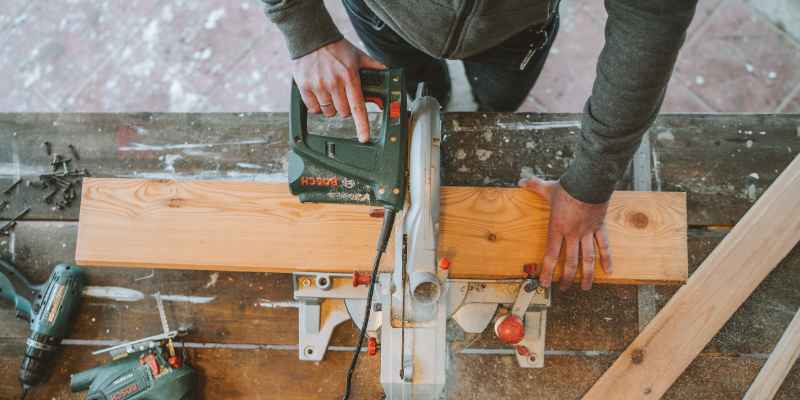Cutting wood panels can be done effectively with a circular saw or a jigsaw. A fine-toothed hand saw or a tenon saw are also viable options for a more controlled and stable cut.
It’s important to cut slowly and steadily to achieve the best outcome. Using a strip of masking tape along the cut line can help keep the panels in place and ensure a clean cut. Additionally, smoothing out rough edges with medium sandpaper can provide a polished finish.
Understanding Different Cutting Tools
Learn the best techniques for cutting wood panels efficiently and accurately. From using circular saws to fine-toothed hand saws, discover the tools and tips that will help you achieve clean and precise cuts for your woodworking projects.
Understanding Different Cutting Tools
Wood panels can be cut using various cutting tools, each suited for different purposes and creating different types of cuts. Understanding the different cutting tools available for cutting wood panels is essential to achieve accurate and clean cuts. Below, we will explore three popular cutting tools for wood panels and their specific uses: the Circular Saw, Jigsaw, and Tenon Saw.
Circular Saw
The circular saw is a versatile power tool commonly used for cutting wood panels. Its circular blade allows for precise and straight cuts, making it suitable for large-scale cutting tasks. The circular saw is an ideal choice for cutting through thick wood panels quickly and efficiently.
Jigsaw
The jigsaw is a handheld power tool equipped with a reciprocating blade, allowing for intricate and curved cuts in wood panels. It is a versatile tool that provides maneuverability, making it suitable for intricate designs and detailed cuts. The jigsaw is perfect for cutting shapes and patterns in wood panels, offering flexibility and precision.
Tenon Saw
The tenon saw, also known as a backsaw, is a traditional hand tool with a thin, fine-toothed blade designed for cutting wood panels with precision and accuracy. It provides exceptional control and stability, making it ideal for making precise, straight cuts in wood panels. The tenon saw is commonly used for woodworking tasks that require a clean and smooth finish.
Understanding the different cutting tools available for cutting wood panels is crucial for achieving desired results. Whether you are cutting straight lines, intricate patterns, or detailed designs, selecting the right cutting tool is essential for ensuring a successful woodworking project.
Explore the possibilities of each cutting tool to determine the most suitable option for your specific wood panel cutting needs. By understanding the unique characteristics and applications of the circular saw, jigsaw, and tenon saw, you can confidently select the appropriate cutting tool to achieve the desired results for your woodworking projects.
Essential Equipment And Materials
When it comes to cutting wood panels, having the right equipment and materials is essential. Whether you’re working on a DIY project or a professional woodworking job, choosing the right panel sizes, using parallel guides, and developing a cutting strategy can make the process smoother and more efficient. In this section, we’ll explore these essential factors in detail.
Choosing The Right Panel Sizes
Before you start cutting wood panels, it’s important to choose the right sizes that you can easily manage. Buying panel sizes that are too large or too heavy can make the cutting process difficult and increase the risk of mistakes or accidents. Consider the limitations of your workspace and the tools you have available. It’s best to opt for panels that you can comfortably handle and maneuver.
Using Parallel Guides
Parallel guides are a great tool to ensure straight and accurate cuts when working with wood panels. These guides act as a support system, keeping your cutting tool on track and preventing it from veering off course. To use parallel guides, simply align them parallel to the desired cutting line and secure them in place. This will provide you with a guide to follow, resulting in clean and precise cuts.
Developing A Cutting Strategy
Having a cutting strategy in place can significantly improve your efficiency and accuracy when cutting wood panels. Before you begin, measure and mark the cutting lines on the panels clearly. This will help you stay on track and minimize errors. Additionally, consider the type of cutting tool you’re using and the techniques that work best for that specific tool. Whether you’re using a circular saw, a jigsaw, or a hand saw, familiarize yourself with the proper techniques and take your time to ensure a clean and smooth cut.
By following these essential tips for cutting wood panels, you can enhance your woodworking skills and achieve professional-looking results. Remember to always prioritize safety and take the necessary precautions when working with power tools. Now that you have an understanding of the essential equipment and materials, you’re ready to tackle your next wood panel cutting project with confidence.
Precision Cutting Techniques
Cutting wood panels with precision is crucial for a flawless finish. Whether you are a seasoned carpenter or a DIY enthusiast, mastering the art of precision cutting techniques is essential to achieve professional results.
Stanley Knife Method
The Stanley knife method involves scoring the wood panel with precision. Start by installing a sharp blade in the Stanley knife and carefully score along the marked line on the panel. This method is ideal for creating straight and clean cuts on wood panels.
Fine-toothed Saw Technique
For intricate cuts and detailed work, the fine-toothed saw technique is highly effective. Utilize a fine-toothed saw to cut through wood panels slowly and steadily. This approach ensures accuracy and allows for intricate designs to be easily achieved.
Using A Mitre Saw
The mitre saw is a powerful tool for making precise angled cuts on wood panels. When using a mitre saw, ensure the panel is securely positioned and the blade is set at the correct angle. This technique is perfect for creating seamless joints and precise corner cuts.
Cutting Different Types Of Wood Panels

When it comes to cutting different types of wood panels, it is essential to use the right tools and techniques for each material. Whether you are working with MDF slat panels, decorative wall panels, or hardboard wall panels, understanding the specific cutting methods can ensure precise and clean cuts.
Mdf Slat Panels
- To cut MDF slat panels, use a handsaw or circular saw for a clean cut.
- For precise cuts, attach masking tape along the cut line to keep the slats in place.
Decorative Wall Panels
- When cutting decorative wall panels, ensure to use a Stanley knife to cut through the material.
- Installing a new blade in the Stanley knife will help in achieving a clean cut.
Hardboard Wall Panels
- Score across the cutting line using a Stanley knife to cut hardboard wall panels.
- For a finer cut, utilize a fine-tooth saw to ensure precision and accuracy.
When preparing to cut wood panels, always prioritize safety by wearing appropriate protective gear and following the manufacturer’s recommendations for the specific material you are working with.
Refining The Edges
When cutting wood panels, refining the edges is crucial for achieving a professional finish. Here are essential steps to refine the edges:
Sanding The Cut Edges
Sanding the cut edges of wood panels is essential to remove roughness and splinters. Follow these steps:
- Begin with a coarse-grit sandpaper to smooth out the rough edges.
- Gradually progress to finer-grit sandpaper for a smoother finish.
- Always sand in the direction of the wood grain for best results.
Smoothing Rough Edges
Smoothing rough edges ensures a clean and polished look for your wood panels. Use these techniques:
- Use a hand plane or block plane to shave off any uneven spots.
- Employ a file or rasp to refine intricate edges and corners.
- Finish off with sandpaper to achieve a uniform texture.
Remember, refining the edges of wood panels not only enhances the aesthetic appeal but also improves the overall quality of your woodworking projects.
Specialized Cutting Situations
When it comes to cutting wood panels, there are certain specialized situations that may require some extra attention and care. In this section, we will dive into three specific scenarios that you may encounter: cutting around outlets, dealing with pre-made wall panels, and creating holes for outlets.
Cutting Around Outlets
One of the challenges you may face when cutting wood panels is navigating around electrical outlets. It’s important to approach this situation with caution to ensure a clean and precise cut. Here are a few steps you can follow:
- Start by marking the area around the outlet on the wood panel. Use a pencil or a masking tape to clearly define the shape and size of the cutout.
- Next, choose an appropriate tool for the job. A jigsaw or a fine-toothed hand saw can provide the control needed for this delicate task.
- If you opt for a jigsaw, attach a fine-toothed blade and follow the marked lines carefully. Take your time and make slow, steady cuts to ensure an even edge.
- If you prefer a hand saw, ensure that you cut slowly and steadily to maintain control and avoid any uneven edges.
- Once the cutout is complete, double-check the fit around the outlet. Smooth any rough edges with sandpaper if necessary.
Dealing With Pre-made Wall Panels
If you are working with pre-made wall panels, it’s essential to understand how to handle them properly to achieve the desired results. Here are a few guidelines to follow:
- Start by measuring the dimensions of the wall panels and compare them to the space you will be installing them in. This will help you determine if any adjustments or cuts are necessary.
- If any cuts are required, use a table saw or a panel saw for precise and accurate cuts. Make sure to follow the manufacturer’s instructions and take all safety precautions.
- When cutting, ensure that you are using the appropriate blade for the material of the wall panel. This will help prevent any damage or splintering.
- After making the cuts, double-check the measurements to ensure a proper fit. Sand down any rough edges if needed.
Creating Holes For Outlets
When installing wood panels on a wall, you may need to create holes for outlets. Here’s how you can do it:
- Start by marking the position of the outlet on the wood panel using a pencil or masking tape.
- Using a drill with a hole saw attachment that matches the size of the outlet, carefully drill a hole through the wood panel. Take your time and apply gentle pressure to prevent any splintering.
- Once the hole is created, test the fit by inserting the outlet into the opening. Make any necessary adjustments or sand down the edges if needed.
Remember, safety should always be your top priority when working with power tools. It’s important to wear appropriate protective gear and follow all manufacturer instructions. By following these guidelines, you can tackle specialized cutting situations confidently and achieve professional-looking results.
Tips For Accurate Cuts

Sure! Here’s an engaging section of a blog post about “How to Cut Wood Panels” with a focus on “Tips for Accurate Cuts”
Scoring Cut Technique
To achieve precise cuts when working with wood panels, consider using the scoring cut technique. This method involves making a shallow incision along the cut line before performing the actual cut. By scoring the surface first, you can minimize splintering and ensure a cleaner, more accurate cut.
Minimizing Splintering
Minimizing splintering is crucial for achieving professional-looking results. To minimize splintering, use a sharp blade or cutting tool, and apply masking tape along the cut line to provide additional support and prevent tear-out. Additionally, consider cutting the panels with the finished side facing down to further minimize splintering.
Professional-level Paneling Cuts
For professional-level paneling cuts, utilizing the right tools and techniques is essential. Consider using a fine-toothed hand saw, tenon saw, jigsaw, or circular saw for cutting wood panels. Each tool offers unique advantages, so choosing the right one based on the specific project requirements is crucial for achieving accurate and professional results.
Common Queries And Expert Answers
Suitable Saws For Paneling
When it comes to cutting wood panels, choosing the right saw is crucial for achieving clean and precise cuts. The most suitable saws for paneling include:
- Circular saw
- Tenon saw
- Jigsaw
- Mitre saw
Circular Saw Techniques
When using a circular saw for paneling, it’s important to employ the right techniques to ensure a smooth cutting process. Here are some expert tips:
- Secure the wood panel firmly in place before cutting
- Use a fine-toothed saw blade for cleaner cuts
- Maintain a steady and controlled cutting speed
Dealing With Woodworking Challenges
Woodworking often comes with its own set of challenges. Here are some expert answers to common woodworking queries:
| Query | Expert Answer |
| How to cut decorative wall panels? | Use a handsaw or circular saw and ensure the slats are kept in place with masking tape for a clean cut. |
| Can you cut wall paneling with a utility knife? | Yes, paneling can be easily cut with a utility knife by using a straight edge as a guide. |
| How to cut paneling on a table saw? | Begin with proper measurements and use a table saw with a sharp blade for accurate cuts. |
Frequently Asked Questions For How To Cut Wood Panels
What’s The Best Way To Cut Wood Paneling?
The best ways to cut wood paneling are using a circular saw or a jigsaw, providing control and stability. For a clean cut, use a fine-toothed hand saw or a tenon saw, taking it slow and steady. Always finish the edges with medium sandpaper for a smooth finish.
How Do You Cut Decorative Wall Panels?
To cut decorative wall panels, use a circular saw or a jigsaw for precise cutting. A fine-toothed hand saw or a tenon saw can also be used for stability. When cutting, do it slowly for a clean edge. You can also use a utility knife or a table saw for this purpose.
How Do You Cut Wood Slat Panels?
To cut wood slat panels, use a handsaw or circular saw. Attach masking tape along the cut line for a clean cut. Smooth rough edges with medium sandpaper.
Can You Cut Wall Paneling With A Utility Knife?
Yes, you can cut wall paneling with a utility knife. It is best to use a new blade and a straight edge (level) for clean cuts. Paneling is typically thin, making it easy to cut with a utility knife.
Conclusion
Cutting wood panels can be a challenging task, but with the right techniques and tools, it can be done easily. Whether you choose a circular saw or a jigsaw, it’s important to cut slowly and steadily to achieve the best result.
A fine-tooth hand saw or a tenon saw can also provide stability and control. Additionally, using masking tape along your cut line can ensure a clean cut. Remember, smoothing the edges with sandpaper can give your wood panels a professional finish.
Happy cutting!


